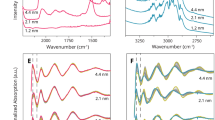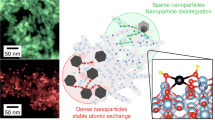Abstract
The poisoning of metal catalysts by sulphur is a serious problem in many chemical processes, but in some cases partial poisoning can produce beneficial changes in catalytic selectivity1,2. The mechanism whereby adsorbed sulphur affects selectivity has been the subject of much debate; one view3 is that during poisoning a restructuring of the metal surface occurs that alters the activity of the catalyst towards structure-sensitive reactions. The adsorption of sulphur can induce ‘faceting’ of macroscopic metal surfaces (see for example ref. 4), so a similar phenomenon might occur when sulphur interacts with the small supported metal particles which are used in practical catalysts. Here I show, using transmission electron microscopy, that sulphur adsorption can produce a transformation in the morphology of alumina-supported platinum particles, which apparently involves the formation of sharp (100) facets. This supports the restructuring model of sulphur poisoning3, and suggests that more attention should be paid to the role of adsorbate-induced faceting in the poisoning and promotion of supported metal catalysts.
This is a preview of subscription content, access via your institution
Access options
Subscribe to this journal
Receive 51 print issues and online access
$199.00 per year
only $3.90 per issue
Buy this article
- Purchase on Springer Link
- Instant access to full article PDF
Prices may be subject to local taxes which are calculated during checkout
Similar content being viewed by others
References
Oudar, J., Catal. Rev.—Sci. Engng 22, 171–195 (1980).
Bartholomew, C. H., Agrawal, P. K. & Katzer, J. R. Adv. Catal. 31, 135–242 (1982).
Somorjai, G. A. J. Catal. 27, 453–456 (1972).
Schmidt, L. D. & Luss, D. J. Catal. 22, 269–279 (1971).
Harris, P. J. F., Boyes, E. D. & Cairns, J. A. J. Catal. 82, 127–146 (1983).
Harris, P. J. F. J. Catal. 97, 527–542 (1986).
McCarroll, J. J., Edmonds, T. & Pitkethly, R. C. Nature 223, 1260–1262 (1969).
Heinemann, K., Osaka, T. & Poppa, H. Ultramicroscopy 12, 9–18 (1983).
Heinemann, K., Osaka, T., Poppa, H. & Avalos-Borja, M. J. Catal. 83, 61–78 (1983).
Park, C., Durrer, W. G., Poppa, H. & Dickinson, J. T. J. Catal. 95, 361–369 (1985).
Gillet, E., Channakhone, S., Matolin, V. & Gillet, M. Surf. Sci. 152/153, 603–614 (1985).
Gillet, M. F. & Channakhone, S. J. Catal. 97, 427–436 (1986).
Wang, T., Lee, C. & Schmidt, L. D. Surf. Sci. 163, 181–197 (1985).
Harris, P. J. F. Appl. Catal. 16, 439–442 (1985).
Romanowski, W. & Lamber, R. Thin Solid Films 127, 139–157 (1985).
Lamber, R. Thin Solid Films 128, L29–L32 (1985).
Author information
Authors and Affiliations
Rights and permissions
About this article
Cite this article
Harris, P. Sulphur-induced faceting of platinum catalyst particles. Nature 323, 792–794 (1986). https://doi.org/10.1038/323792a0
Received:
Accepted:
Issue Date:
DOI: https://doi.org/10.1038/323792a0
This article is cited by
-
Stabilization of 4H hexagonal phase in gold nanoribbons
Nature Communications (2015)
-
Surface modification-induced phase transformation of hexagonal close-packed gold square sheets
Nature Communications (2015)
-
Visualization of oscillatory behaviour of Pt nanoparticles catalysing CO oxidation
Nature Materials (2014)
-
Dynamic in situ observation of rapid size and shape change of supported Pd nanoparticles during CO/NO cycling
Nature Materials (2007)
-
High resolution electron microscopy characterization of sulfided palladium particles on amorphous SiO2
Catalysis Letters (1994)
Comments
By submitting a comment you agree to abide by our Terms and Community Guidelines. If you find something abusive or that does not comply with our terms or guidelines please flag it as inappropriate.



